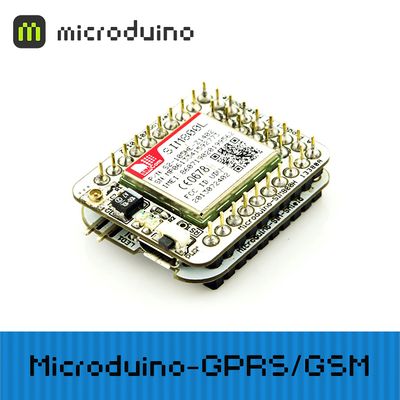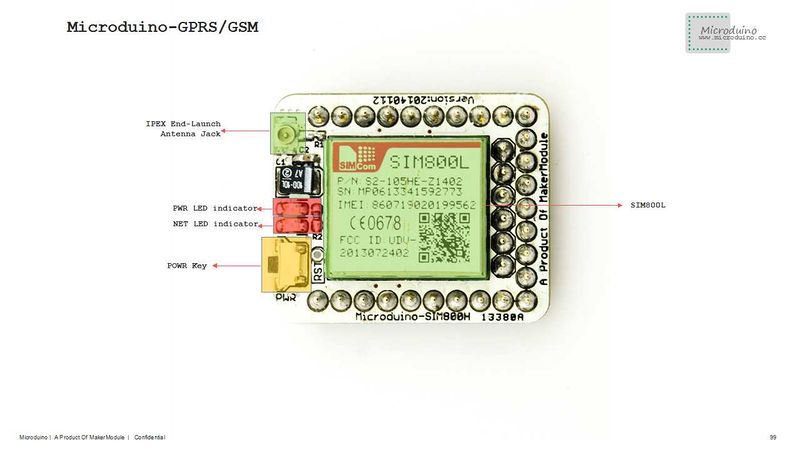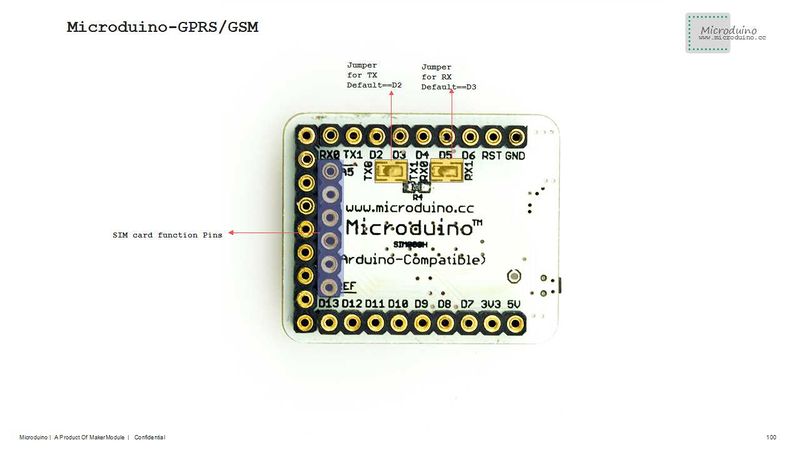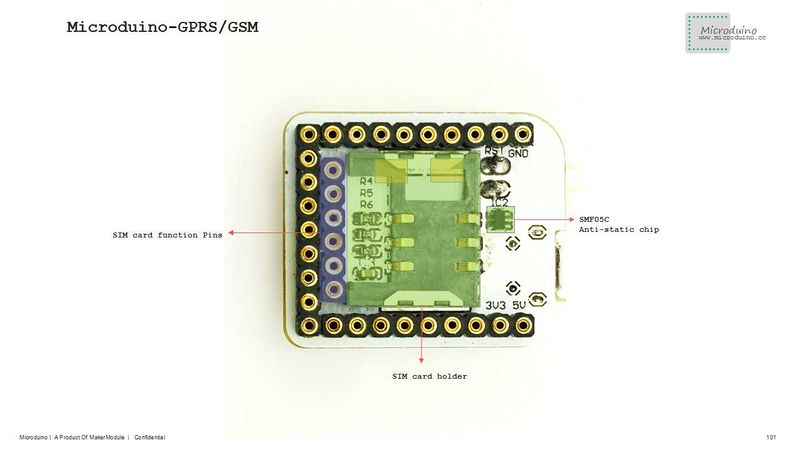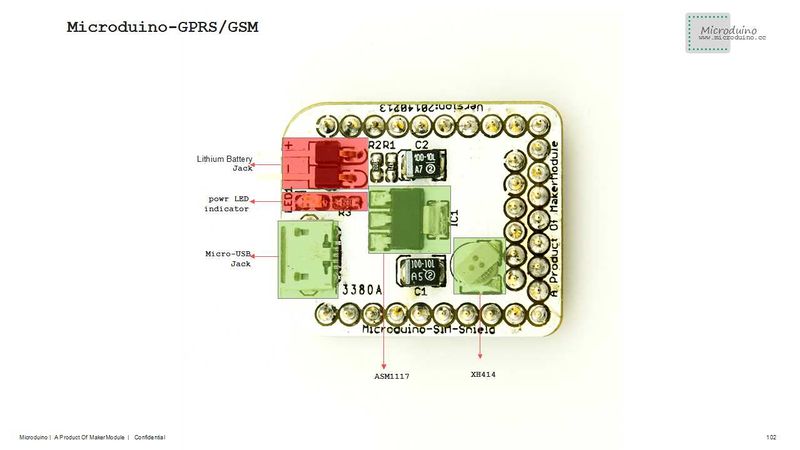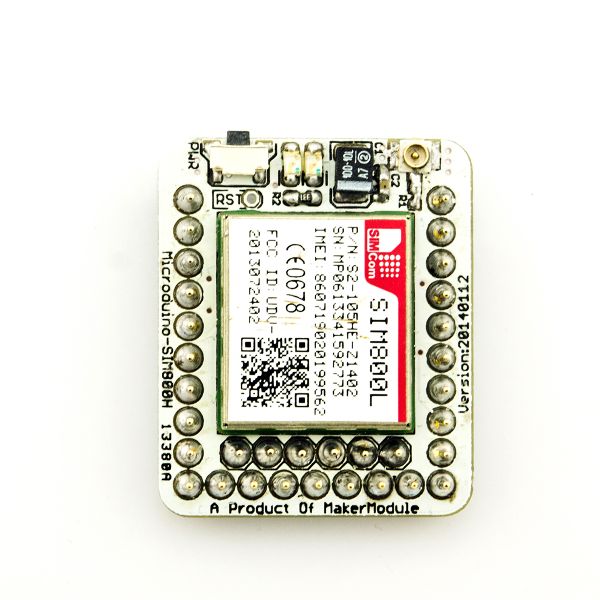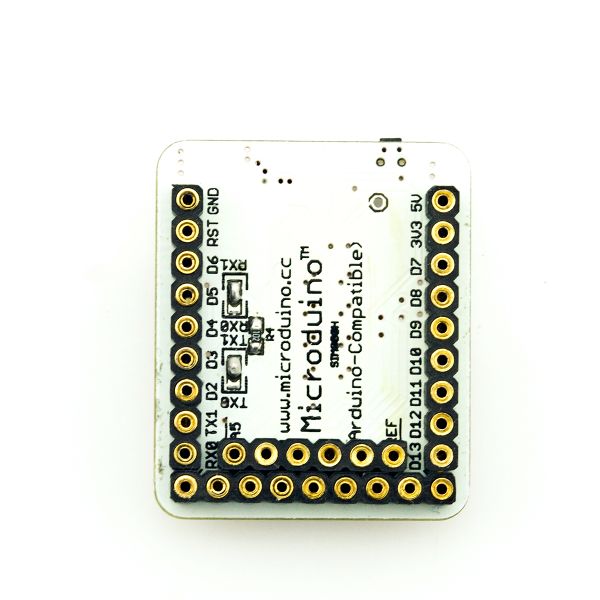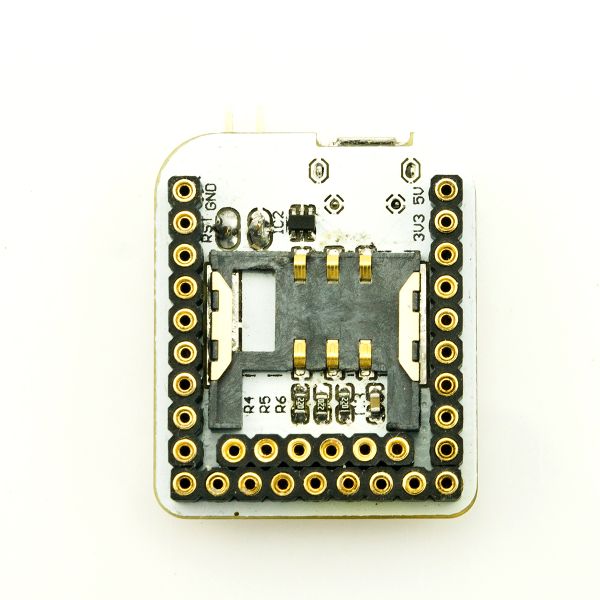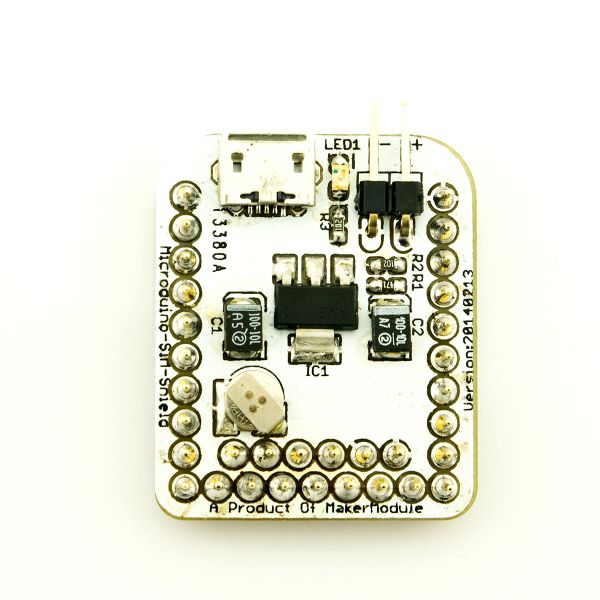Difference between revisions of "Microduino-GPRS/GSM"
From Microduino Wiki
(Created page with "{{Language | Microduino-GPRS/GSM}} {| style="width: 800px;" |- | 400px|thumb|right|Microduino-USBHOST Microduino GPRS/GSM module plug in the...") |
(→Development) |
||
| (16 intermediate revisions by 4 users not shown) | |||
| Line 5: | Line 5: | ||
[[File:Microduino-GPRS-rect.jpg|400px|thumb|right|Microduino-USBHOST]] | [[File:Microduino-GPRS-rect.jpg|400px|thumb|right|Microduino-USBHOST]] | ||
| − | Microduino GPRS/GSM module | + | Microduino-GPRS/GSM module can get Microduino core board connected to the internet and achieve the function of sending and receiving messages when it is just inserted with a SIM card and follows some simple instructions. |
==Features== | ==Features== | ||
| − | *ESD | + | *ESD protection; |
| − | * | + | *Capable of being charged by USB, li-ion or other power supply options; |
| − | * | + | *Support automatic baud rate detection function; |
| − | * | + | *Capable of sending AT instructions and data through the serial port; |
| − | *Small, cheap, stackable | + | *Small, cheap, stackable and open; |
| − | *Open | + | *Open hardware circuit design and Arduino compatible programming development environment; |
| − | * | + | *Uniform Microduino interface standard and rich peripheral modules, capable of having a fast and flexible connection and extension with other modules and sensors in accord with Microduino interface standard; |
| − | *2. | + | *Easy to be integrated to pegboards with a 2.45-pitch female header connector interface. |
==Specifications== | ==Specifications== | ||
| − | + | Adopt SIM800L module to support four-band GSM/GPRS, whose working band is:GSM850, EGSM900, DCS1800 and PCS1900MHz. | |
*Electrical characteristics | *Electrical characteristics | ||
**Working voltage:3.4V ~4.4V; | **Working voltage:3.4V ~4.4V; | ||
| − | ** | + | **The current consumption is 0.7 mA under the Sleep Mode |
*GPRS data | *GPRS data | ||
| − | **GPRS | + | **The maximum data transmission rate of GPRS is 85.6 kbps;; |
**Build-in TCP/IP protocol; | **Build-in TCP/IP protocol; | ||
**Encoding format:CS-1, CS-2, CS-3 and CS-4; | **Encoding format:CS-1, CS-2, CS-3 and CS-4; | ||
**Support Unstructured Supplementary Service Data (USSD) | **Support Unstructured Supplementary Service Data (USSD) | ||
| − | *Serial | + | *Serial debugging |
| − | ** | + | **Support standard full-function serial as well as the transmission rate with a range from 1200bps to 115200bps; |
| − | ** | + | **Support the serial port multiplexing function complying with GSM 07.10 protocol; |
| − | *Two Main | + | *Two Main Components: |
**SIM800L module | **SIM800L module | ||
[[file:Microduino-SIM800L-Pinout1.jpg|800px|thumb|center|Microduino-SIM800L-Pinout]] | [[file:Microduino-SIM800L-Pinout1.jpg|800px|thumb|center|Microduino-SIM800L-Pinout]] | ||
| Line 45: | Line 45: | ||
==Document== | ==Document== | ||
*Eagle PCB: '''[[File:Microduino-GSM.zip]]''' | *Eagle PCB: '''[[File:Microduino-GSM.zip]]''' | ||
| − | * Microduino-GSM | + | * Microduino-GSM module SIM800L:'''[[File:SIM800L.pdf]]''' |
| − | *SIM card | + | *Microduino-GSM Module TCPIP Protocol AT Instruction Manual:'''[[File:Microduino-GSM-AT.pdf]]''' |
| + | *SIM card base:'''[[File:SIM800L.pdf]]''' | ||
==Development== | ==Development== | ||
| − | You can use GSM library to test, https://github.com/Microduino/Microduino_Tutorials/tree/master/Microduino_Libraries/ | + | You can use GSM library to test, https://github.com/Microduino/Microduino_Tutorials/tree/master/Microduino_Libraries/_03_Microduino_GSM_SIM800L |
| − | ''' | + | ==Application== |
| + | Send short messages using the example program. | ||
| + | ===Preparation=== | ||
| + | *Hardware:Microduino FT232R, Microduino Core, Microduino GSM, USB cable or lithium battery; | ||
| + | *Software: GSM library, Arduino IDE (version 1.0.3 and higher); | ||
| + | *Uncompressed the zip folder to libraries of Arduino IDE; | ||
| + | *Connect the Microduino FT232R and PC using USB cable to download program and monitor the serial port; | ||
| + | *USB cable or li-ion battery to charge the Microduino GSM module and press the power button for a long time to activate Microduino GSM for about 4 seconds. That the power-on indicator goes on shows a successful start. | ||
| + | |||
| + | ===Debugging=== | ||
| + | *Download the test program:'''[https://github.com/Microduino/Microduino_Tutorials/blob/25a821ba8894fb02d4b1560c9912450cc353b875/Microduino_Texting/Microduino_GPRS_GSM_text/Microduino_GPRS_GSM_text.ino Github Download]''' | ||
| + | *Open the test program, and then you need double check the following parameter: | ||
| + | **“#define NUM "13667928xxx"”:Need change to the number that receive message. | ||
| + | **“#define SMS_CEN "13010720xxx"”:Your message center for you own mobile phone number, you can find it in your phone. It isn't the necessary. If hit an issue during send a message, you can try it. | ||
| + | *Compile the program, select the board type "Microduino Core+ (Atmega644P@16M,5V)", download directly: | ||
| + | *Open the serial monitor, set the baud rate is 9600: | ||
| + | **Input "t", to send the message "wiki.microduino.cc"; | ||
| + | **Input "d", you can make a call, but can't finish a normal call, because no the speaker and microphone; | ||
| + | **Input "h", you can submit a HTTP request to get some data from network; | ||
| + | **Input "s", you can send the sensor data to network. | ||
| − | + | *If using Microduino-Core to debug, you need the soft serial port(TX1, RX1) | |
| − | + | *If you use the Microduino Core to debug, must use the Software Serail (TX1,RX1) | |
| − | + | **Use the Software Serial library | |
| − | + | <source lang="cpp"> | |
| − | * | + | #include <SoftwareSerial.h> |
| − | * | ||
| − | |||
| − | |||
| + | SoftwareSerial mySerial(2, 3); // RX, TX | ||
| + | </source> | ||
| + | **Change the Serial1 to mySerial, it should be ok。 | ||
| − | + | *If you use the Microduino CoreUSB to debug, you only need to change the serial to serial 0 (TX0,RX0). | |
| − | * | + | [[file:Microduino-SIM800L-Pinout2.jpg|800px|thumb|center|Microduino-SIM800L-Pinout]] |
| − | |||
| − | |||
| − | |||
| − | |||
| + | ==FAQ== | ||
| + | *Can this module be used to make a voice call? Is a pin available for voice? | ||
| + | **This module can’t be used to make a voice call, because it doesn’t have the required pin. | ||
| + | *Does this module work with Core+ module? | ||
| + | **Yes. | ||
| + | *Does this module use Arduino GSM library? | ||
| + | **Yes. | ||
| + | *Does this module work with 3G? | ||
| + | **No, it only supports GPRS and GSM. | ||
| + | *How is this module powered? | ||
| + | **There are two methods: | ||
| + | ***Using the USB port attached to the module with a 5V, 1A power supply (Voltage 5V, Amperage 1A) | ||
| + | ***Using a 3.7V Li-ion battery attached to the module | ||
| + | '''The BM module can power the Core module and other modules, such as the 10DOF. However, use of the BM module to power the GPRS/GSM module is not suggested due to its significant power consumption.'' | ||
| − | == | + | ==Purchase== |
==History== | ==History== | ||
Latest revision as of 17:10, 5 January 2015
| Language: | English • 中文 |
|---|
|
Microduino-GPRS/GSM module can get Microduino core board connected to the internet and achieve the function of sending and receiving messages when it is just inserted with a SIM card and follows some simple instructions. Contents[hide]Features
SpecificationsAdopt SIM800L module to support four-band GSM/GPRS, whose working band is:GSM850, EGSM900, DCS1800 and PCS1900MHz.
Document
DevelopmentYou can use GSM library to test, https://github.com/Microduino/Microduino_Tutorials/tree/master/Microduino_Libraries/_03_Microduino_GSM_SIM800L ApplicationSend short messages using the example program. Preparation
Debugging
#include <SoftwareSerial.h>
SoftwareSerial mySerial(2, 3); // RX, TX
FAQ
'The BM module can power the Core module and other modules, such as the 10DOF. However, use of the BM module to power the GPRS/GSM module is not suggested due to its significant power consumption. PurchaseHistoryPictureVideo |
